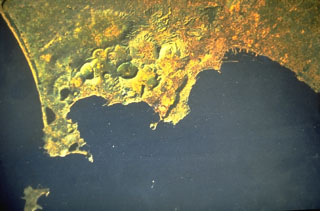Report on Campi Flegrei (Italy) — January 1985
Scientific Event Alert Network Bulletin, vol. 10, no. 1 (January 1985)
Managing Editor: Lindsay McClelland.
Campi Flegrei (Italy) Seismicity declines; slight deflation
Please cite this report as:
Global Volcanism Program, 1985. Report on Campi Flegrei (Italy) (McClelland, L., ed.). Scientific Event Alert Network Bulletin, 10:1. Smithsonian Institution. https://doi.org/10.5479/si.GVP.SEAN198501-211010
Campi Flegrei
Italy
40.827°N, 14.139°E; summit elev. 458 m
All times are local (unless otherwise noted)
"A magnitude 3.8 earthquake occurred on 8 December and was located on the E side of Solfatara Crater. After this event, the seismic activity was very low during December and January. During December the tide gauges in the Gulf of Pozzuoli recorded no uplift of the ground in the area. In the second week of January, a slight deflation was measured by the Pozzuoli tide gauge. Only the radon contents of water in monitored wells showed an increase. In mid-November the values were similar to those in the corresponding period of December 1983-January 1984. We are waiting for a longer quiescence period before releasing a ceased alert warning."
Geological Summary. Campi Flegrei is a 13-km-wide caldera that encompasses part of Naples and extends to the south beneath the Gulf of Pozzuoli. Episodes of significant uplift and subsidence within the dominantly trachytic caldera have occurred since Roman times. The earliest known eruptive products are dated 47,000 years BP. The caldera formed following two large explosive eruptions, the massive Campanian ignimbrite about 36,000 BP, and the over 40 km3 Neapolitan Yellow Tuff (NYT) about 15,000 BP. Following eruption of the NYT a large number of eruptions originated from widely scattered subaerial and submarine vents. Most activity occurred during three intervals: 15,000-9,500, 8,600-8,200, and 4,800-3,800 BP. The latest eruption were in 1158 CE at Solfatara and activity in 1538 CE that formed the Monte Nuovo cinder cone.
Information Contacts: G. Luongo and R. Scandone, OV; F. Barberi, Univ. di Pisa.

